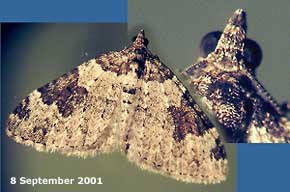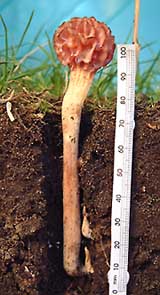Go to latest entry.....................................Go to previous entry
On the bird front, It was amusing this morning to watch the sparrows (20-3) sitting at the top of the Hawthorn sunbathing as the sun rose over the house. Most of the time they stayed quiet, except when I was using a circular saw when they all chirped loudly. This afternoon their chatter in the hawthorn was rudely interrupted when the Sparrowhawk crashed into the tree. The glimpse I caught of its grey colour makes me think it was a male. I did not see if it carried anything away when it left. The young Dunnock was here again before lunch.
Looking down into the hole I can see some more, very small stalks, each with a spherical 'head'. I have two guides to fungi (Penguin Nature Series) but this one is not shown in them. This little creature, measuring 7mm long with much longer, and very delicate legs is an Assassin Bug (Empicoris vagabundus). It found me this afternoon when it flew into the house through an open window. I though it was a mosquito and grabbed at it. Fortunately, it survived my assault and was quite cooperative, moving around on a table in a very 'stealthy' way. Click on the image for a larger view.
3 September - Just a brief entry today. The fungus described above has yet to be identified. By this evening the 'head' had grown to about 10-12mm across, but looks just the same, and the stalk seems to be a little darker. The small growths in the hole are only marginally bigger in size (<2mm across).
It does not appear in some of the main fungus ID books for the UK so investigations continue into what it could be. In contrast to this fungus you may see a small conical shape in the bottom left corner of the main picture. This is the top of a very different fungus that is sharing the hole.
This is it. A small, gill fungus with a deep red stem (also unidentified so far!). The scale shows the largest specimen measuring just 4mm across, dwarfed by its orange neighbour. The 'toppled' specimen was quite deep down the hole and I only just managed to get close enough to focus by using a microscope lens on the camera (see my technical section for details!). Today a robin came to feed near the house, the first time I have seen one here for a week or so. Also there were two Great Tits feeding around the Birch tree. A large (female - I think) Sparrowhawk perched on top of the Leylandii for a short time this morning. Although there were quite a few sparrows in the Hawthorn she did not attack and just glided away after a couple of minutes. We seem to have lost our blackbird(s). I have only seen one female on one occasion since coming home from our holidays. There is food, including apples waiting for them to re-appear.
A look in my books suggests that they belong to the Hygrophoraceae family. I must get to a book shop to look at and probably buy the Roger Philips book on British Fungi.
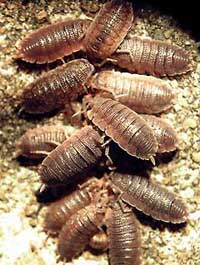
8 September - First of all, an image from last night. The woodlice were very active on our front path. I assume that this group had found something of mutual interest, possibly some decaying matter.
Here is an up-to-date image of the mystery fungus. The only change that I can see is that the frills are getting larger. This morning the head measures some 23-24mm wide. It is still defeating efforts to identify it. (click on image for large version)
9 September - I have taken some more images of the mystery fungus this morning, click here to see today's large image (62.7KB). I have sent an e-mail to Kew Gardens in the hope that they can help with its identification.
Interestingly, I read that the female drops her eggs while flying and the caterpillars feed on roots of grasses and other plants.
This second moth appeared on our patio window last night. It is a Garden Carpet (Xanthorhoe Fluctuata), one of commonest of European moths. Its caterpillars feed on Wallflowers, currant bushes, cabbages and other Cruciferae. The close-up image shows its right antenna, positioned behind the bulbous eye and tucked back under the wing. While we see some moths at night we still see few butterflies by day, except for Large Whites, and some Small Whites. Unfortunately I can never get close enough to get a decent photograph of one. The bird scene remains very quiet at the moment, except for the sparrow chorus. Collared Doves and Blue Tits are regular visitors with occasional visits from the Great Tits. A Robin is becoming more regular and less timid , and today a second one appeared but did not stay.
The picture shows the fungus still in position with half the hole cut away to expose the stem. This is longer than I had already estimated. If you click on the image you can see a large image with some details not visible previously.
11 September - Today was not a good day to even think about the garden as the people of New York and Washington feared for their lives as a result of mindless terrorism. It is hard to concentrate on the wonders of nature when we are faced by inhumane barbarism of the magnitude seen today. My thoughts go out to the families caught up in this crime against humanity. 12 September - This morning I had an e-mail from Dr Peter Roberts at Kew, having seen the fungi that I sent him yesterday. Here is what he says about the mystery fungus, I quote - "Your collections arrived ok this morning. As suggested, the weird morel-like specimen is a teratological form of the more normal toadstool you enclosed (and pictured on your web-site). Both are Laccaria laccata, sometimes known as "the Deceiver" since it is very variable in size, shape, and colour. It is an ectomycorrhizal species, forming a mutually beneficial association with roots of certain trees and shrubs. Laccaria species seem particularly inclined to form strange fruit bodies, but the cause (genetic, virus, mycoplasma?) is unknown, at least to me. The specimen was perfectly fertile, happily producing spores. We will retain it in the British National Collections of fungi in the herbarium at Kew." For comparison, I had sent Dr Roberts one of the orange gill fungi that I pictured on 6 September as it was growing in the same part of the garden. For anyone who, like me has not come across the term teratological, it describes a 'biological malformation or abnormal growth'. Today I have been going some remedial woodwork on my garden/driveway gate and so I have had very little opportunity to do things in the garden. I did spend some time watching a Dunnock feeding under the Hawthorn. A Robin turned up but there was no dispute between the two birds. |
|
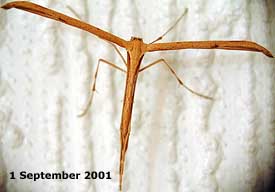
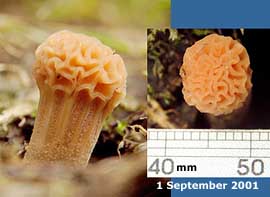
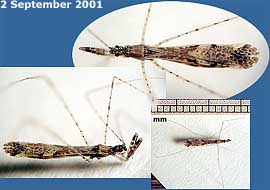
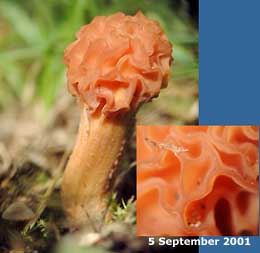
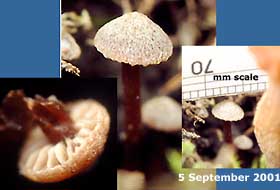
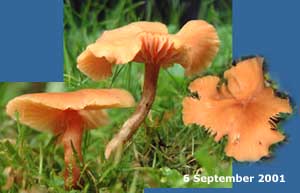
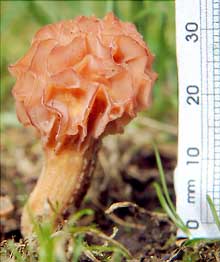
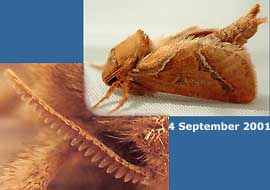 Here
are two moth pictures taken during the week. The first was found
in the house on Monday evening (and the image forgetten about).
I believe it to be an Orange Swift (Hepialis sylvina).
It is a moth that I have seen frequently here in the past.
Here
are two moth pictures taken during the week. The first was found
in the house on Monday evening (and the image forgetten about).
I believe it to be an Orange Swift (Hepialis sylvina).
It is a moth that I have seen frequently here in the past.